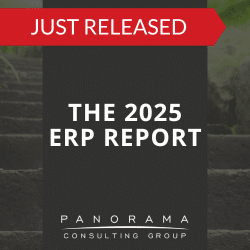As businesses seek to modernize their legacy systems and integrate disparate systems, they’re turning to modern enterprise software.
Enterprise software, like customer relationship management (CRM) and enterprise resource planning (ERP) systems, help companies access accurate, real-time data – but only if these two systems are integrated.
Today, we’re sharing a few ways that ERP and CRM data integration can transform your operations.
What are CRM and ERP?
Before we dive into the advantages of system integration, let’s briefly cover the core functions of CRM and ERP.
In short, CRM facilitates customer engagement. It allows companies to organize all their accounts in one place. This provides a 360-degree view of the customer lifecycle, so employees are always up-to-date on where each client stands.
The data from a CRM system also helps employees provide more personalized service to each account. In-depth customer intelligence provides data on behavior, preferences, and other critical information.
An ERP system, on the other hand, helps to streamline a company’s essential business functions. For instance, accounting departments can automate many of their manual, spreadsheet-based processes, so they can focus less on route administrative work.
Another example is in human resources. HR teams can automate a portion of the onboarding process, reducing paperwork, so new hires can start work faster.
Essential business data exists in both ERP and CRM platforms. However, this data typically exists in siloes.
The 2025 ERP Report
72.6% of respondents said they've already deployed AI at their organizations. Learn about AI adoption and other ERP trends by downloading our latest report.
4 Benefits of ERP and CRM Data Integration
1. Automated Account-Based Processes
By combining ERP and CRM, companies can automate some of the key processes that drive their account-based operations. They have a complete view of all customer data, including but not limited to order information, supply chain information, and financial information.
These two integrated systems can perform functions such as automating a new sales order or synchronizing contracts. As soon as a deal is closed in the CRM database, it can travel to the ERP platform, where it becomes an official sales order. Likewise, when product or price lists are updated, this data updates instantly on the CRM side, so sales teams have access to the latest data.
By syncing customer and contract information, companies can reduce or eliminate manual data entry. They also minimize the potential for data errors.
Ultimately, ERP and CRM data integration means orders are expedited, inventory is easier to manage, and revenue gets recorded sooner.
2. Improved Reporting and Analytics
Robust data reporting allows companies to accurately predict what will happen based on previous customer history, so they can stay one step ahead of trends and changes in buyer behavior.
When CRM and ERP systems work together, companies can tap into deeper insights that show how each client interacts with their business. Based on this, the software can predict how customers may act in the future, so companies can plan their sales and warehouse operations accordingly.
3. Enhanced Sales Functionality
Increasingly, both current and prospective customers crave personalization. They expect brands to approach them by name and understand their likes and preferences before they even share them.
Years ago, this type of mind-reading might have seemed impossible. However, thanks to the analytics described above, it’s now attainable.
When sales teams have access to this array of information, they can tailor their approach to meet the needs of each client. In addition to seeing sales-based information, employees can see exactly where an order is in the supply chain. This means that if a customer wants a delivery update or information on product lead times, the software can automatically provide detailed insights.
4. Easier Cross-Department Collaboration
Every day, employees working in different departments must communicate with one another and share information. Salespersons must contact the warehouse, and HR teams must work with project managers. Meanwhile, accounting experts are calling the C-suite and marketing personnel, while collaborating with customer service representatives.
Traditionally, these teams would access an internal network to store and share files through a folder-based system. Not only was this time-consuming to navigate, but it also led to issues with version control and user access. It became even more complicated when these insights were spread across different machines and systems in multiple locations.
With integrated CRM and ERP software, all authorized users can log into a shared central platform. They all have access to the same information in real time. If someone makes a change to the data, it updates across the board.
This helps employees work together more easily, so they can reach their shared goals. It also reduces communication breakdowns and operational siloes, which indirectly improves employee morale.
What Benefits are You Missing Out On?
The benefits of ERP and CRM data integration are vast. By integrating these systems, businesses can improve the customer experience.
If you’re already using a CRM system, then consider adding an ERP platform to expand those operations. Likewise, a CRM system can be an ideal accompaniment to an existing ERP system.
Interested in learning more about CRM or ERP implementation? Contact our ERP consulting firm below for a free consultation.













